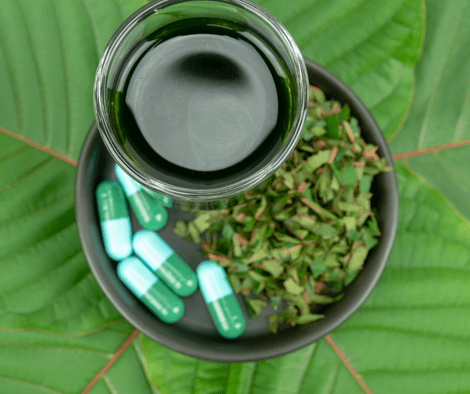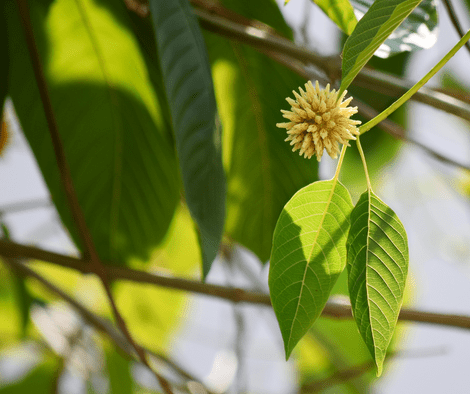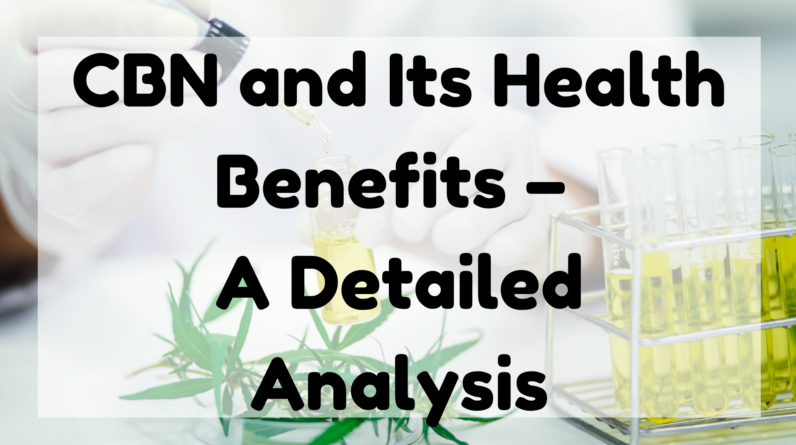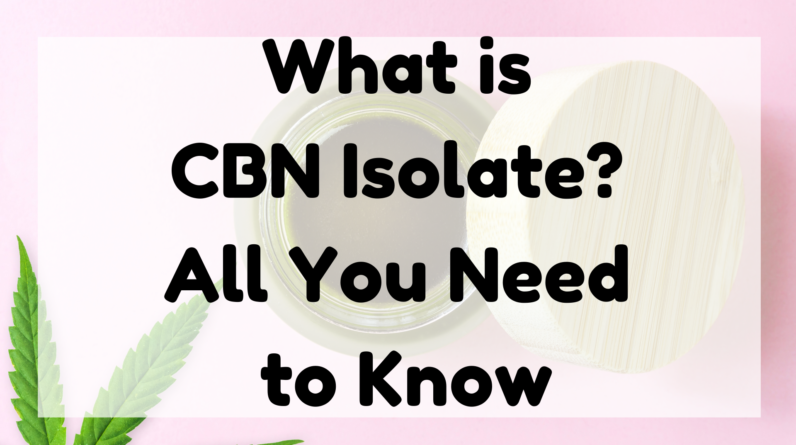

What Is Kratom? A Detailed Guide
Kratom comes from the Mitragyna speciosa tree, native to Southeast Asia.
It has lately gained popularity in the West, with some suggesting that its leaves provide significant health advantages.
Despite the absence of scientific data, there appears to be some evidence to support these claims and various hazards associated with Kratom tea intake.
Continue reading to learn more about Kratom, including its advantages and disadvantages.
What do you mean by Kratom?
Kratom is a botanical drug derived from the Mitragyna speciosa plant, native to Thailand and other Southeast Asian countries.
When misused, Kratom may effectively make someone “high.”
It is classified as a restricted substance in Thailand and is the third most often misused illicit narcotic.
The Drug Enforcement Administration (DEA) has designated Kratom as a “drug of concern” in the United States, even though it is neither restricted nor prohibited in most states.

This drink, popular among young Muslims in southern Thailand, is reported to produce effects comparable to alcohol intoxication.
In the United States, Kratom is most typically sold in powder or tablet form as a dietary or nutritional supplement or under the radar in tobacco or head shops.
Kratom has a long list of claimed applications and intended benefits, from sexual enhancement to pain relief to a “safe” and legal “high,” Kratom has a long list of claimed applications and intended benefits.
Kratom may be marketed as a cocktail called ketum at bars in North Carolina, New York, Colorado, and potentially other states.
What are the health benefits of Kratom?
Kratom produces effects similar to a moderate stimulant when used in small doses.
After using this herbal medication, many users report a boost in energy, concentration, mental clarity, and sociability.
The amount of energy is similar to that of a caffeine high.
The effects may become more sedative as the dosage is increased.
It has the potential to bore a casual user both emotionally and physically.
Mitragynine and 7-hydroxy mitragynine are the primary active alkaloids responsible for most physiological alterations after intake.
Below are some of the benefits of using Kratom:
1. Kratom can mitigate anxiety:
According to research, people from Thailand and Malaysia, where Kratom is grown, chewed a few kratom leaves before social gatherings or events.
The goal was to remain calm and relaxed, allowing them to be more friendly and less worried.
To this day, Kratom is mostly employed for its potential capacity to modulate mental traffic.
Many individuals believe that Kratom makes them more chatty and friendly.
Anxiety is a worldwide health concern, and bringing Kratom into the conversation about anxiety management techniques might be beneficial.
2. Kratom can be a great energy booster:
Remember that Kratom comes in a variety of strains. Each strain has its own unique set of traits.
While some may cause drowsiness, others may have the same effect as coffee.
They may make you feel more enthusiastic and motivated, helping you complete everyday tasks faster.
Many people are moving from coffee to kratom tea in the morning.
Kratom works by aiding specific metabolic processes to improve.
This improves circulation and increases the amount of oxygenated blood in the body.
All of this can result in a rush of energy.
People living with Chronic fatigue syndrome might benefit from Maeng Da, Thai kratom, and white vein kratom.
3. Helps in managing depression:
Even while Kratom isn’t opioid-like codeine or morphine, the way it makes its way into the system is quite similar.
However, the results are quite similar.
Mitragynine, the active alkaloid, attaches to the opioid receptors, giving a sense of pain relief and alleviation.
Many users report that this activity is responsible for the anti-anxiety and antidepressant-like benefits.
There is currently very little study on the effects of Kratom on mood and anxiety.
It’s crucial to note that not all strains or types of kratom products have anti-anxiety properties.
A user would have to conduct a study to identify a potential product on the market.
To expect those results, it’s also necessary to select an optimum personal dose.
As a result, it’s critical to only purchase kratom and kratom products from a reputable source/vendor.
It’s also critical to take it in little amounts. Anxiety and sadness may be temporarily alleviated by using Kratom.
4. Anti-pain and anti-inflammatory effects:
Research gave some information on Kratom’s immune-boosting and anti-inflammatory properties.
Many people who take Kratom believe that it helps them get rid of long-term symptoms and aches.
Individuals frequently turn to opioids and over-the-counter medications and pharmaceuticals to relieve pain.
While more concrete data is needed to help push Kratom into the mainstream market, anecdotal evidence grows daily.
HCG injections provide comfort for many persons who have fibromyalgia and chronic pain.
Kratom may have similar pain-relieving properties to some extent.
5. It might aid in the recovery of some addictions:
The research was carried out in May 2019.
The purpose was to address some of the most frequently asked issues about Kratom and its use.
The results were mixed, according to the researchers.
While there is no shortage of anecdotal evidence and tales circulating on the internet, regulatory agencies like the FDA require more controlled clinical research.
Only based on such clinical trials can Kratom be classified as a safe and effective treatment for opioids and other addictions.
It’s noteworthy that despite the apparent absence of large-scale studies, consumers continue to turn to Kratom for addiction relief.
In a small-scale study conducted by Malaysian males in 2009, Kratom was shown to aid with withdrawal symptoms.
What are the health risks of using Kratom?
Because Kratom has such powerful chemicals, you should get medical advice before using it or any other supplement.
Before you start using Kratom, keep the following in mind:
Side effects:
The most typical adverse effects of kratom usage are nausea and constipation, although some users may also experience the following:
- Itching
- Mouth is parched
- Sweating
- Dizziness
- Damage to the liver
- Seizures
- Hallucinations
Long term effects:
One research looked into the long-term consequences of kratom consumption.
Darkened face skin, dry mouth, frequent urination, anorexia, weight loss, and regular constipation were all mentioned by participants.
Withdrawal symptoms:
The following withdrawal symptoms have been reported after frequent and sustained Kratom use:
- Aggression
- Jerky leg motions
- Hostility
- Pain in the muscles and bones
- Lack of capacity to work
Everything you need to know about the uses of Kratom

According to an FDA study, Kratom is an agonist that binds to mu-opioid receptors in the brain.
These receptors are triggered when you use opioids like prescription medications or heroin.
Kratom is a kind of natural opioid. It has intolerance, reliance, and withdrawal concerns like other opioids.
Mitragynine and 7-hydroxy mitragynine are thought to aid pain management by binding to opioid receptors, reducing pain perception.
Kratom is becoming more popular as an alternative to opioid medications such as OxyContin (oxycodone) and Vicodin (hydrocodone).
Persons who use Kratom in the United States tend to be middle-aged, middle-income people who are suffering from pain, according to the findings of an online poll conducted in 2014.
More than 8,000 people who responded to the poll indicated using Kratom to relieve pain or boost their mood.
A smaller but substantial percentage stated they were taking it to support them quit opioid medicines (a type of pain reliever) or manage opioid withdrawal.
Why is it controversial?
Kratom isn’t officially recommended for medical use because it hasn’t been fully examined.
In the discovery of novel medications, clinical trials are critical.
The use of studies aids in discovering common adverse effects and drug combinations.
These researches also aid in the determination of efficient and safe doses.
Kratom has a powerful effect on the human body.
The quantity of alkaloids in Kratom is similar to that of opium and hallucinogenic mushrooms.
Humans are affected by alkaloids in a great way.
While some of these consequences may be beneficial, others may be harmful.
This emphasizes the necessity for more research in this sector of medicine.
There are significant risks of bad outcomes, and safety has yet to be shown.
According to one animal research, mitragynine, the main psychoactive alkaloid in Kratom, may have addictive qualities.
Nausea, sweating, tremors, difficulty sleeping, and hallucinations are some of the common negative addiction symptoms.
Furthermore, kratom manufacturing is unregulated. The FDA does not regulate herbal safety and purity.
There are no recognized guidelines for safely generating this medicine.
What do experts have to say about Kratom?
Other experts disagree, claiming that it is not the “miracle remedy” that some claim to be.
There is relatively little published research on Kratom’s potential usefulness as a pain reliever and opioid substitute.
According to the findings, a 2010 investigation published in the International Journal on Drug Policy examined 136 persons who used Kratom and found that the plant was “characterized as inexpensive, easily available and having no major negative effects despite prolonged usage,” the findings.
This paper did not test Kratom’s health effects or possible risks.
Researchers assessed 293 persons who frequently used Kratom and found that more than half had developed significant dependency problems, including kratom withdrawal symptoms including muscular spasms, sleep disturbance, rage, and stress, according to a 2014 paper published in Drug and Alcohol Dependence.
Kratom may not reduce respiration as much as other pain-relieving medicines like morphine, according to mouse research published in the Journal of Medicinal Chemistry in 2016.
5 Given that respiratory depression is a common cause of mortality from opiate overdose, the study’s findings imply that more research into the chemicals in Kratom is necessary.
According to a 2019 assessment, Kratom has some potential advantages but a significant risk of misuse, interactions, and negative side effects.
6 The assessment also advised that putting it behind the counter of a pharmacy may be a good compromise between banning the drug and allowing it to be sold freely.
Signs of using Kratom
If you or someone you care about is taking Kratom, be aware of the common side effects (such as talkativeness, increased social behavior, itching, changes in appetite, and sweating), as well as any odd or excessive changes in mood, behavior, appearance, or general health.
What are some of the common questions people ask regarding Kratom?
Many individuals assume that Kratom is safe to consume because it is a herbal supplement.
However, it’s vital to remember that the FDA doesn’t control supplements before they’re sold.
Consequently, there’s no way of knowing if a supplement contains the components specified on the label (or that those ingredients will appear in the indicated amounts).
It’s possible to get contaminated or adulterated with other medications, plants, or substances.
How long does Kratom stay in your system?
To discover the exact half-life of Kratom, more study is required.
The length of time kratom lingers in your system, like other drugs, is determined by the following factors:
- Usage frequency
- Body fat percentage by age
- Genetics
- Consumption of water and food
- Rate of metabolization
- Type of Kratom
Kratom Addiction:
According to the DEA, Kratom usage may develop into addiction and cause psychotic symptoms such as hallucinations, delusions, and disorientation.
Although not everyone may experience addiction similarly, there are certain common indications and symptoms, such as tolerance, dependence, and withdrawal.
Other frequent addiction symptoms include:
- Mood swings, sleep habits, weight gain, and activity levels
- Friendship shifts
- Loss of passion for hobbies, social activities, work, or school
- Stealing, lying, and/or secrecy are all examples of unethical behavior.
- Having financial difficulties
- If you’re having trouble reducing or ending your drug use, talk to your doctor.
- Investing a significant amount of time in acquiring, consuming, and recuperating from the drug
- Keeping drug or paraphernalia stashes
How to get assistance for Kratom usage?
It’s not easy to live with pain.
If you live with pain, you’re probably well aware of how detrimental it can be to your quality of life.
If you’re thinking about using Kratom, you should first consult your doctor.
Several pain clinics combine complementary and alternative therapies with established medical techniques for pain treatment and management.
Mindfulness (and other mind-body techniques) may, for example, assist some persons in maintaining pain management despite the stresses of daily life.
Get treatment right now if you’ve been self-medicating with Kratom and have recognized that it’s taking over your life.
A qualified healthcare practitioner can assist you in getting back on track.
Is Kratom safe to use?
While some individuals use Kratom as a pain reliever instead of pharmaceutical painkillers like opioids, little study has been done on how it affects the body.
The Food and Drug Administration (FDA) in the United States has not authorized it for any medicinal use.
Kratom can have negative side effects, especially at large dosages.
These responses are seizures, tremors, psychosis, and other major toxic consequences.
People with medical issues and those who take other drugs are at a higher risk of experiencing negative effects from Kratom.
It’s important to remember that the FDA doesn’t regulate or monitor kratom supplements for dose or quality.
What are the effects of using Kratom?
Depending on the dosage, Kratom has various effects on the body.
Sedation effects:
Kratom can have a sedative effect at larger dosages of 5–15 g.
Opioids induce users to feel drowsy, tranquil, and euphoric, comparable to this sensation.
Higher dosages are often used to treat severe coughs, diarrhea, or opiate withdrawal symptoms.
Doses more than 15 g can cause drowsiness and sedation, resulting in loss of consciousness.
Stimulant effects:
Kratom can be a stimulant in extremely tiny dosages of 1–5 grams (g), increasing consumers’ energy.
They may feel more alert and gregarious, as well as more chatty.
In the United States, how is Kratom Used?
According to a 2016 online study of over 8,000 kratom consumers mostly reached through the AKA, the majority reported utilizing the medication to relieve pain or cure mood disorders, including sadness and anxiety.
According to the poll, Kratom was most commonly ingested as a powder blended into a drink or tablet form and was published in the journal Drug and Alcohol Dependence by Oliver Grundmann, a clinical associate professor of medicinal chemistry at the University of Florida.
Is there proof that Kratom has health benefits?
We don’t have clinical trials or rigorous studies like we do for pharmaceuticals that the FDA demands before a drug can reach the market since we don’t have them yet.
Before dietary supplements may be sold, that stringent “gold standard” is unnecessary;
Instead, we have positive applications recorded in a traditional environment in East Asia, and surveys and user reports in the United States and Europe.
Most people said they felt better after taking doses of up to five grams three times a day.
As long as we evaluate how much Kratom is being used and what products are being utilized, we can state reasonably solid anecdotal emerging evidence that Kratom offers advantages for the ordinary user.
While some anecdotal reports of improvements are encouraging, several experts are pushing for greater study.
What are some of the best Kratom products to use?
Below are four of the best Kratom products that we strongly recommend,
1. Kratom Tea Bags (15 counts):
There are 15 tea bags in each packet. There are 4 grams of crushed kratom leaves in each tea bag.
It has been naturally engineered from Southeast Asia’s rainforests.
Super Speciosa obtains its Kratom from reputable harvesters in Borneo’s rainforests who use sustainable and clean practices.
Their leaf is dried inside and then ground into a fine powder to avoid contamination.
They employ an organic technique that we created in-house to gently treat the Kratom and eliminate pollutants while preserving the plant’s integrity.
Independent labs test impurities, pollutants, and contaminants.
Their facilities and equipment are designed to be as clean as possible, and they never wrap anything by hand.
You get a natural product you can rely on when you add it all together!

2. Green Bali Kratom Tablets:
Each kratom pill contains around 300mg of 100% pure pressed kratom leaf.
The tablet is held together without the use of binders or capsule barriers.
There are approximately 500 pills in the bag.
- All-natural, premium-grade kratom leaf powder.
- View lab certifications with the use of a QR code.
- Contaminants, heavy metals, and pollutants were all tested.
- There are no additives or fillers in this leaf, only the leaf itself.

3. Super Speciosa Kratom Capsules:
There are 60 vegan capsules in each jar. Approximately 600mg of kratom powder is contained in each capsule.
A third-party examination verifies their facilities, and their Kratom satisfies the American Kratom Association’s GMP quality and safety requirements.

4. Red Borneo Kratom Powder:
Transparency is crucial to Super Speciosa, and they believe that seeing is believing.
They are the first company to use scannable QR codes on product labels to link to lab certifications for authenticity, potency, and contaminants.
Others talk about quality but fall short when it comes to accomplishing something.
This is when Super Speciosa enters the picture.
In a market where “buyer beware” is a common phrase, they have made quality control a key concern.

Summary
Southeast Asians have been using and consuming Kratom for a long time.
The health advantages of Kratom, on the other hand, remain uncertain.
Meanwhile, experts have a lot of proof that Kratom is harmful to one’s health, especially when used in excessive dosages.
Although some health gurus profit from generating interest in natural cures, it is critical to think about alternative therapies in terms of science.
While Kratom is lawful in the United States, it poses a major risk to persons with medical issues and those who take other prescriptions.
Even though it may have some medicinal benefits, there is very little research to back up its use.
Anyone considering Kratom should be informed of the hazards and see a physician before doing so.
References
- https://americanaddictioncenters.org/kratom/does-it-get-you-high
- https://health.clevelandclinic.org/what-is-kratom/
- https://www.webmd.com/diet/health-benefits-kratom
- https://www.medicalnewstoday.com/articles/kratom-tea
- https://www.credihealth.com/blog/health-benefits-of-kratom/
- https://www.healthline.com/health/food-nutrition/is-kratom-safe
NEXT HolistaPet CBD
Legal and Medical Disclaimer
Information provided on the site is for educational purposes only, and does not substitute for professional medical advice.
You MUST consult a medical professional or healthcare provider if seeking medical advice, diagnoses, or treatment.
Additionally, you must consult your local and federal laws regarding the legality of buying CBD and THC products.
We do not provide any legal advise.








